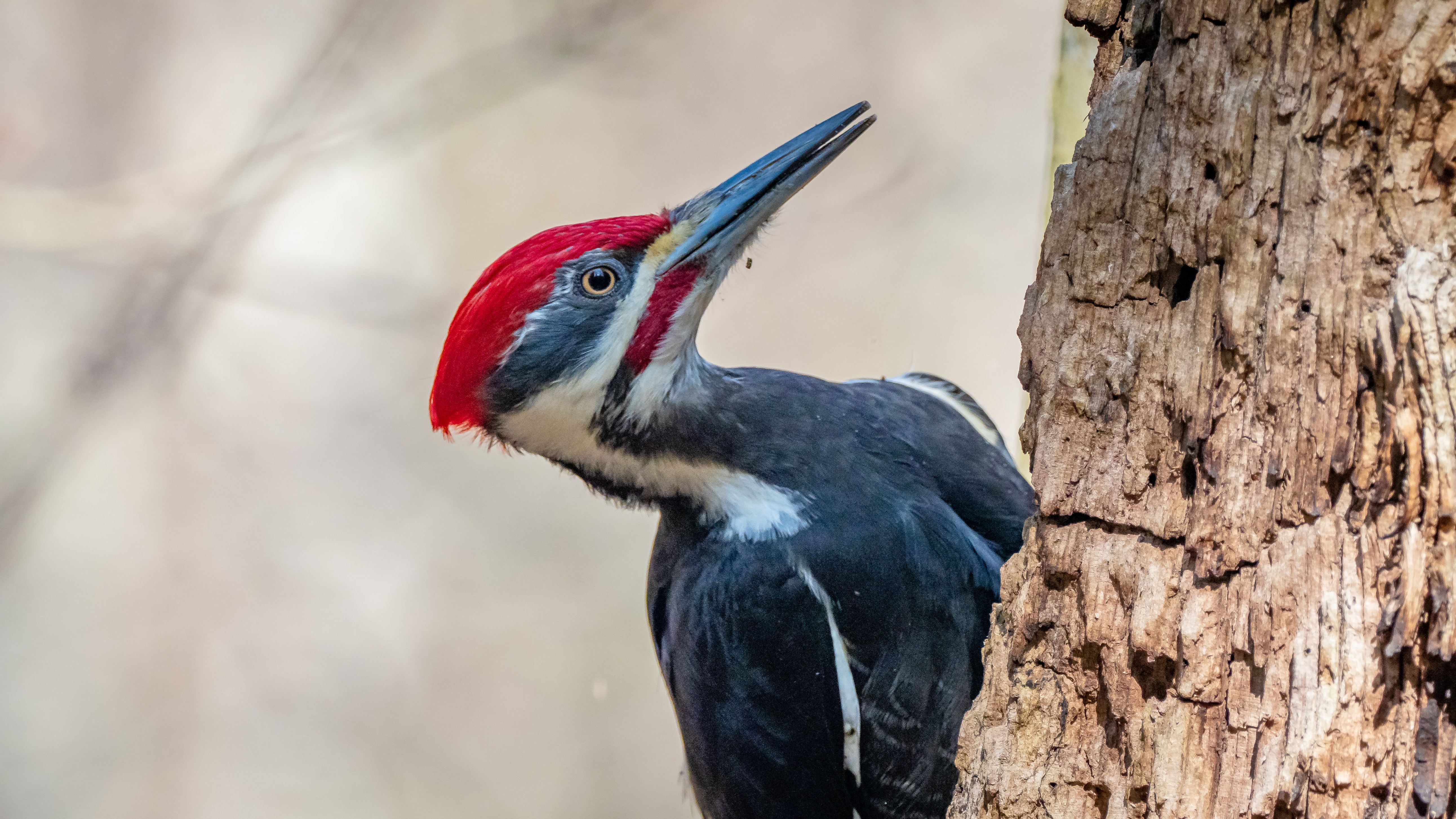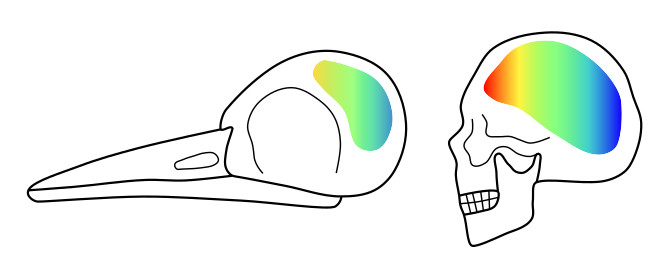Why woodpeckers don't need a helmet.
By Maja Mielke

Pileated woodpecker. Image by Patrice Bouchard from unsplash.
“Why Don’t Woodpeckers Get Headaches?” is the title of Mike O’Connors book about “bird questions you know you want to ask” (see here). Probably anyone who has watched one of these birds slamming their heads against tree trunks has wondered how they can’t get headaches.
Over the years, the idea that woodpeckers must have some kind of shock absorbing system has been widely communicated. Now hold on. I must tell you that this is wrong. They don’t have shock absorbers. And there is a good reason for this. Keep reading if you want to learn why!
Woodpeckers love hammering. They use it not only for the search of food, but also for building breeding cavities, to communicate with fellow woodpeckers, and to claim their territory. Upon impact, their head reaches velocities of up to 7 meters per second. That is more than 25 km/h (15.5 mph)! That is like a human running against a wall in full sprint. We might suffer from severe head injuries and maybe even a concussion. But woodpeckers don’t seem to mind. They keep on pecking - up to 20 times per second and up to 12.000 times per day!
Surely there must be specific adaptations that protect the birds brain? It seems intuitive that the woodpecker skull might have some kind of in-built shock absorbing system. Such a system could absorb parts of the impact force to prevent the brain from hitting the wall of the skull too hard. However, from a biomechanical and evolutionary point of view this wouldn’t be plausible at all. But why?
The shock-absorber-paradox
Imagine, you want to drive a nail into a tree. Surly a hammer is your tool of choice. It is hard and solid, so perfectly adapted to produce high impacts. However, imagine trying to do this with a hammer that has a shock absorber, e.g. a spring dampening the impact. You would need more hits and more energy to drive the same nail into the same tree.

A shock-absorbing hammer is just not a good hammer. Image by Maja Mielke.
It is the same with woodpeckers. They have evolved to produce high impacts in order to advance into a tree as efficient as possible. This could be for building a breeding cavity, for example. If their skull had a shock absorber, the impact would be reduced and the bird would need to hit more often and with more force to finish the cavity.

Diagram: Maja Mielke.
I was lucky enough to be part of a research team that investigated this phenomenon in more detail (see the full study here). In our study, we used computer models to simulate pecking into wood with and without shock absorbers. The latter showed a much poorer pecking performance, i.e. much less penetration depth when hitting the wood with the same force. In fact, a multiple of the force would be needed to achieve the same penetration depth like the beak without shock absorber.
Understanding this leads to the logical next question: While a selective pressure during the evolution of woodpeckers made them specialized in high-impact pecking, why should a protective mechanism have evolved at the same time that impairs this pecking?

Cover image of the Current Biology journal with our study. Photo ©Minden Pictures.
On the hunt with high-speed cameras
In order to find out whether woodpeckers have a shock absorber or not, we used high-speed cameras to record videos of hammering woodpeckers. We filmed pileated woodpeckers (Dryocopus pileatus), black woodpeckers (Dryocopus martius), and great spotted woodpeckes (Dendrocopos major). Because it is difficult to get standardized high-quality videos of woodpeckers in the wild, we filmed the birds in the laboratory or in zoos. With the high-speed videos, we could analyse how fast the birds’ beak and head are slowed down (decelerated) upon impact. The higher the deceleration, the higher the potential risk for the brain. If a shock absorber where present in the skull, an area between beak tip and skull would be compressed like a spring, which would diminish the deceleration of the brain. In the video analysis, this would show as a delayed deceleration of the skull compared to the beak. However, we did not find such an effect: beak and skull showed an identical and simultaneous deceleration. Thus, the woodpecker’s skull is solid like a hammer, i.e. adapted to highly efficient pecking. But how can it be that the brain still does not suffer from injuries?
No headaches thanks to the laws of physics
The answer is relatively simple: F = m∙a. This basic law of classical mechanics, also known as Newton’s second law, means that the force F equals the product of mass m and acceleration (or deceleration) a. If a body, e.g. the brain of a woodpecker, is decelerated by a, the resulting force is the smaller the smaller the mass of that body is. And indeed, woodpeckers have a relatively small, i.e. lightweight, brain (not only compared to humans, but also compared to similar sized but non-pecking birds). Hence, the force that acts on the brain upon its impact on the skull wall is relatively small. Small enough to not harm the brain. Indeed, computer simulations showed that the birds would need to hammer four times as hard, or hammer against four times harder materials, to reach the threshold for a potential concussion.
There are two more special features in the woodpecker brain that increase its tolerance against hard impacts. First, the brain is relatively tightly packed in the skull, i.e. there is only little amounts of cerebrospinal fluid between brain and skull wall. This limits the brain’s mobility within the skull and also the force that acts on the brain upon impact on the skull wall. Second, the brain of woodpeckers, which is approximately hemispherical like ours, is mounted more upright than in humans (see fig). Thus, the large, flat area faces more forward. This way, the acting forces during pecking are distributed over a larger area, which reduces the pressure (force per area) acting on the brain. If your interested to dive deeper into these fascinating adaptations, there is a nice youtube playlist from the MIT (ref).

The orientation of the brain helps the woodpecker to reduce the pressure acting on the brain. Diagram: Maja Mielke.
Well then?
The results of this study contradict decades of misbelief. Information about a shock-absorbing woodpecker skull have been widely distributed: in children’s books, educational videos, nature documentaries, info panels in zoos, etc. It won’t be easy the re-write what has been widely accepted as the woodpeckers’ solution to protect their brains. I hope that this blog post helps to do so. And if you have read until here, you can help as well! Next time you and your friends or family encounter a woodpecker on a walk through the forest, please announce that woodpeckers don’t have and don’t need a shock-absorbing skull, because their brains are light and conveniently oriented. No headaches with all this pecking.
Thanks for reading! If you have any questions or comments or just want so say hi, I will be happy to hear from you. Feel free to email me!